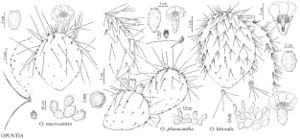Difference between revisions of "Opuntia phaeacantha"
Mem. Amer. Acad. Arts, n. s. 4: 51. 1849.
FNA>Volume Importer |
imported>Volume Importer |
||
| (2 intermediate revisions by 2 users not shown) | |||
| Line 8: | Line 8: | ||
}} | }} | ||
|common_names=Brown-spined pricklypear | |common_names=Brown-spined pricklypear | ||
| + | |special_status={{Treatment/ID/Special_status | ||
| + | |code=F | ||
| + | |label=Illustrated | ||
| + | }} | ||
|basionyms= | |basionyms= | ||
|synonyms={{Treatment/ID/Synonym | |synonyms={{Treatment/ID/Synonym | ||
| Line 67: | Line 71: | ||
|publication title=Mem. Amer. Acad. Arts, n. s. | |publication title=Mem. Amer. Acad. Arts, n. s. | ||
|publication year=1849 | |publication year=1849 | ||
| − | |special status= | + | |special status=Illustrated |
| − | |source xml=https:// | + | |source xml=https://bitbucket.org/aafc-mbb/fna-data-curation/src/2e0870ddd59836b60bcf96646a41e87ea5a5943a/coarse_grained_fna_xml/V4/V4_262.xml |
|subfamily=Cactaceae subfam. Opuntioideae | |subfamily=Cactaceae subfam. Opuntioideae | ||
|genus=Opuntia | |genus=Opuntia | ||
Latest revision as of 21:57, 5 November 2020
Shrubs, decumbent to commonly trailing, 0.3–1 m. Stem segments not disarticulating, green to dark green, sometimes reddish under stress, flattened, obovate to circular, 10–25 × 7–20 cm, low tuberculate, glabrous; areoles 5–7 per diagonal row across midstem segment, obovate to elliptic, 3–6 × 2–4 mm; wool tan to brown, aging grayish. Spines (0–)2–8 per areole, at most areoles to only distal 1/4 of stem segment, or essentially absent, brown to white, straight, curved, or spirally twisted; major central spines deflexed or spreading, brown to red-brown (to blackish), or partly to wholly gray to tan, subulate, usually flattened near base, 30–80 mm; abaxial spines usually 1–3, deflexed, white, flattened, shorter, to 20 mm. Glochids dense in crescent at adaxial edge of areole and subapical tuft, tan to red-brown, to 5 mm. Flowers: inner tepals yellow with red basal portions (rarely entirely pink to red), 30–40 mm; filaments greenish basally, pale yellow to white distally; anthers yellow; style white; stigma lobes green to yellow-green. Fruits wine red to purple, with greenish flesh (sometimes reddish and ± juicy), not long stipitate, obovate to barrel-shaped, 30–50 × 20–30 mm, fleshy, glabrous, spineless; areoles 18–24. Seeds tan, subcircular, 4–5 mm diam., evidently notched, warped; girdle protruding 1 mm. 2n = 66.
Phenology: Flowering late spring (Apr–Jul).
Habitat: Deserts, chaparral, surrounding mountains, plains, sandy to rocky soils
Elevation: 200-2100 m
Distribution

Ariz., Calif., Colo., Kans., Nev., N.Mex., Okla., Tex., Utah, Mexico.
Discussion
Much of the material formerly assigned to varieties of Opuntia phaeacantha has been segregated as O. engelmannii. Various combinations of overlapping character states make separation of O. phaeacantha var. major from var. phaeacantha impractical. Presumably var. major comprises sprawling to erect shrubs with obovate stem segments bearing usually few darker colored spines (usually one to three) per areole, in the distal half of the stem segment or less, whereas plants of var. phaeacantha are trailing shrubs with narrowly obovate stem segments bearing more spines (usually three to ten) per areole throughout most to all of the stem segment. Recently some workers have applied O. camanchica Engelmann & Bigelow to those plants with the very dark colored spines and merged vars. major and phaeacantha. Distinctions among taxa are further blurred by hybridization of O. phaeacantha with O. engelmannii, yielding several named and unnamed hybrids, including O. wootonii Griffiths. Morphologic and genetic analyses of the populations are needed before correct names can be assigned to many of these plants with confidence.
Opuntia phaeacantha also hybridizes with O. aureispina (forming O. ×spinosibacca), O. ficus-indica, and O. littoralis (forming O. ×vaseyi), and members of the O. polyacantha complex, particularly near the regions of Grand Canyon and Four Corners.
Selected References
None.
